The death of Alexander Graham Bell arouses renewed interest in the great inventor’s connection with Martha’s Vineyard. Bell’s concern with the island and its people was much more than a thing of the moment. His visits and at least one prolonged stay on the island were the result of his desire to investigate the so-called “deaf-mute” town in Chilmark about which a fictitious tradition had sprung up.
It is also true that while Bell was living in Capt. Abram Osborn’s house in Edgartown, the telephone was taking form and Bell put in much work on the invention. When he left the island he had made strong friendships which were parted only by death.
On his arrival on the Vineyard, Bell went directly to Chilmark in order to study the deaf-mutes. His interest in the subject is said to have been stimulated by the fact that Mrs. Bell was deaf. In spite of her affliction, Bell could talk to her for long periods in technical language about his inventions and she would rarely have to ask a question, so adept had she become at the reading of lips.
At Chilmark Bell was soon referred to Richard L. Pease of Edgartown as being the one person best able to supply him with the desired information. Journeying at once to Edgartown Bell soon found Mr. Pease whose knowledge relating to Vineyard families proved complete and satisfying. In speaking of him shortly afterward to Mrs. Pease, Bell exclaimed “Why, I’ve found a mine in Mr. Pease!”
In this manner a friendship sprang up between the two men which lasted with undiminished warmth until the death of Mr. Pease.
On one occasion when Mr. Pease returned from Washington after visiting Prof. Bell he brought with him a gift from Mrs. Bell to Mrs. Pease, which proved to be an album of Mrs. Bell’s sketches of Scottish scenery. This valued book is now in the possession of Miss Charlotte pease of Edgartown who turns its pages for you to its seventh picture which proves a satisfying view of “Milton Cottage Trinity,” and beneath which we note in fine handwriting the phrase “A. G. B. playground.” As Miss Pease closes this book one pictures the great Inventor of the Telephone at play there among the hollyhocks, carefree of fame, and just a Boy.
An interesting side-light on Bell at Edgartown is furnished by the account of James L. Humphrey of New Bedford who met him there.
Bell had gone to Edgartown on the verge of a nervous collapse, according to the story he told Mr. Humphrey at that time. He had engaged room and board for the winter in a hotel with the stipulations that the place was to be his to do absolutely as he wanted and that strict privacy should prevail to the exclusion of other boarders.
Then a salesman “making” Edgartown, Mr. Humphrey arrived at the hotel one stormy nigh after all lights were out. After prolonged knocking he aroused the host, Captain Osborn. The ban on intrusion by others was explained by the Captain. Only after Mr. Humphrey set forth his plight at that time of night and in such bad weather did Captain Osborn relinquish his rule against additional roomers - for which rule, he told Mr. Humphrey, the stranger, who later proved to be Bell, “paid well.”
Curious over the whol affair, Mr. Humphrey began to devote his efforts to find out what this work was that must not be interfered with. He discovered that everything that Mr. Bell did he accomplished with inflexible regularity. He would read for exactly an hour and stop on the stroke of the clock. He would play the piano just one hour. If out walking, he would be back in an hour to the very second. So in his experiments on the invention that was later to be the finished telephone.
At last Mr. Humphrey asked him just what his idea was in following this 60-minute schedule. Bell explained he did it to rest his mind through a change of task. He said he alternated an hour with his telephone work and an hour on something else. He informed Mr. Humphrey that he cared nothing for society, but wished only for a place to work.
Mr. Humphrey in his youth did not realize the importance of the work Bell had underway and could not convince himself that the newcomer’s peculiarities were particularly sound. With others in Edgartown, Mr. Humphrey neglected to continue his interest in the invention that was later to bring fame to Bell and wealth to those who promoted the telephone.
“And so I lost the only chance I ever had of cultivating the acquaintance of one of the three greatest inventors of the age,” is the way Mr. Humphrey summed it up regretfully.
The result of Bell’s investigation of the deaf-mutes is preserved in a “Memoir upon the Formation of a Deaf Variety of the Human Race,” published by the National Academy of Sciences in 1883.
The outstanding feature to the Vineyarder’s eye is that Bell gives a rational and natural explanation of the deaf-mute situation in Chilmark. There is no sensational tale of “inbreeding” or any other abnormal element. Bell goes back to deaf-mute persons whose children came to the Vineyard. By the ordinary process of heredity, the deaf-mute characteristics prevailed in varying proportions in the families of deaf-mutes. From one or two individuals in the beginning, these characteristics were transmitted by intermarriage and especially through large families until the number of deaf-mutes had greatly increased.
Bell wrote, “Certain diseases are to be known to be liable to transmission by heredity. But we do not find epileptics marrying epileptics, or consumptives knowingly marrying consumptives. Even though persons afflicted with the same hereditary disease were to intermarry for a number of successive generations, it is doubtful whether any permanent variety of the race could be formed in this way, for the increased tendency to disease inherited by the offspring would probably cause a greater tendency to premature death and ultimately cause the extinction of the variety.”
It was Bell’s great concern that deaf-mutes married deaf-mutes almost invariably. The factors which he pointed out in the above quotation did not hold in relation to deaf-mutes. On the contrary, through constant association, a language of their own, and a complete differentiation from other people, deaf-mutes became a separate social group. With intermarriage of deaf-mutes an invariable rule, the succeeding generations must of necessity inherit the defect. Unlike other human beings with as serious a defect, there was nothing to keep deaf-mutes from multiplying and continuing in strength and longevity.
Bell believed it to be a serious matter for the defect of deafness - a grave handicap to a human being - to be perpetuated, but even more than that actually bred into a deaf variety of the human race.
His memoir contained a large number of suggestions for guarding against such a possibility. His attitude toward deaf persons was most human and personal, and his suggestions were of striking common sense, clarity and thoughtfulness for the deaf mute persons.
So interested was bell in the subject that he compiled elaborate tables and graphs. He charted the descent of hundreds of deaf persons and delved deep into genealogy to discover the inheritance of deafness.
Of some interest to Vineyarders is Bell’s tracing of the generations of the Brown family of Henniker, N.H. through which he follows deafness to Chilmark.

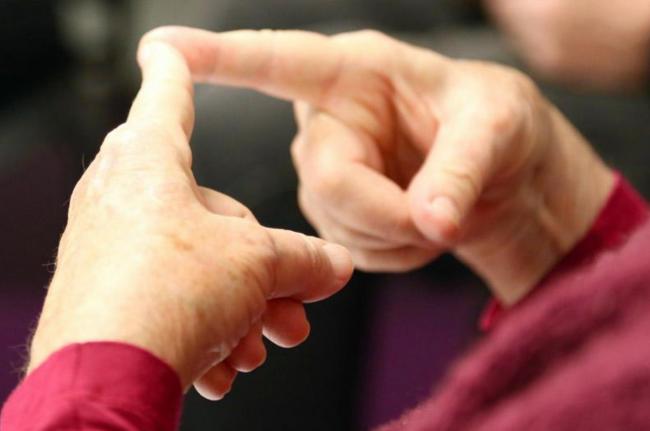
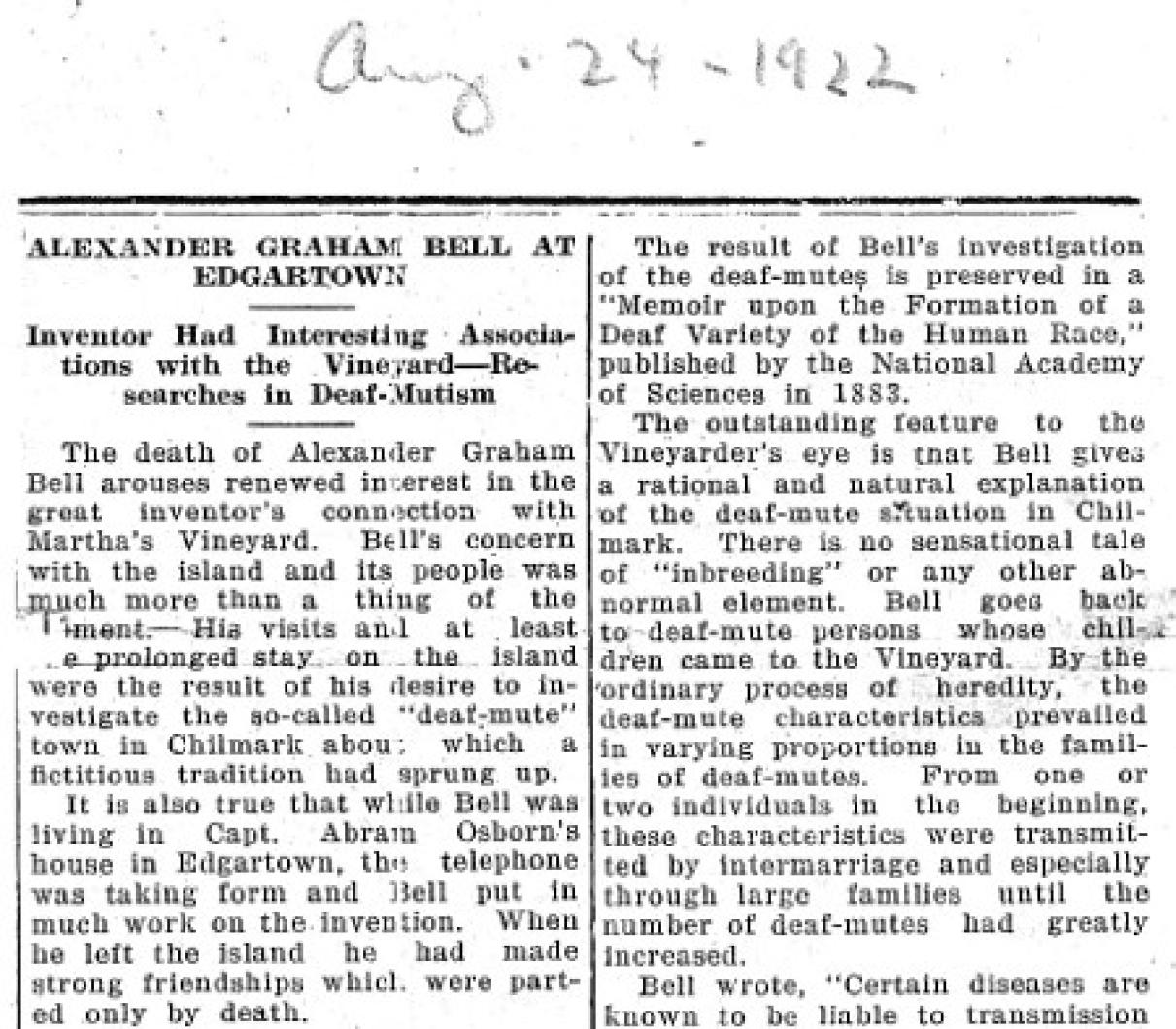




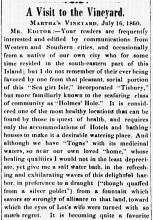
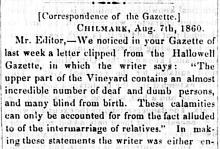
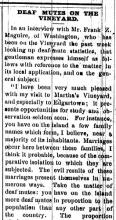

Comments